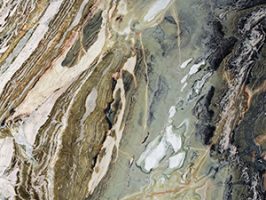Pinterest, Houzz, magazines, and other kitchen and bath design resources recommend both quartzite and quartz for kitchen countertops, floors, walls, backsplashes, and more. Sometimes people confuse the two materials, given their similar names and appearances, but they are actually very different.
Quartzite
Quartzite is a natural stone. Sandstone that is subjected to heat and pressure forms quartzite. Quartzite's appearance can be veined like marble, have more solid coloring, look like crushed crystals, or a combination of these features. On the Mohs scale of hardness, quartzite is usually around a seven or eight out of ten, which means it is harder than glass.
Quartzite is also very durable, but subject to staining or etching like most natural stones. Since quartzite is porous, sealing it can help inhibit staining, but sealers cannot prevent etching. There are new solutions now available on the market for quartzite countertop etch protection. Maintenance requirements include frequent cleaning with a stone-safe, pH-neutral cleaner and periodic professional restoration services, which may include honing, polishing, cleaning, and re-sealing.
Quartz
Quartz is a mineral, and in its powdered form, it is the main ingredient for the engineered stone also called quartz. With patterns mimicking marble and other natural stone, quartz requires less maintenance than natural stone. Quartz does not require sealer, because it is not porous, but this doesn't necessarily mean it is impervious to damage. The good news is that quartz does not damage easily. The bad news is that although quartz is harder to damage than quartzite, once it is damaged, it is more problematic to restore because it is made with colored resin.
Feel free to contact us with specific questions about quartzite, quartz, or other materials.
This is one of a series of articles written and published on behalf of Surface Care PRO Partners.

